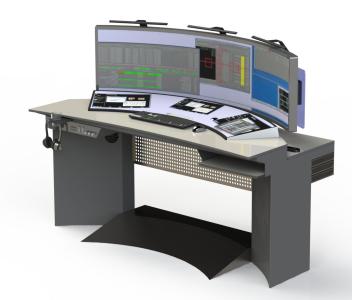Advanced Ergonomics on HCI for Satellite M C, Problem Analysis, Design Planning Activities and Support for Critical Operation Phases

The objectives of this study would be - to examine the suitability of recent developments in ergonomics to improve the interaction of users with the ground segment systems.- Investigate the use of large high resolution touch displays to support operational and engineering activities. In particular, routine MC, problem analysis (e.g. spacecraft anomalies), common design activities (e.g. software engineering) and support for critical operations. - Prototyping and installation of the proposed technologies (wall-mounted high-resolution touch display, large touch displays for operators, graphic padsThis will improve the interaction of users with the ground segment systems
Typically the human computer interface used on current operational systems consists of a three headed workstation with a keyboard and mouse. During mission critical phases the flight control team and associated support personnel (who are typically distributed throughout different rooms) wear headsets and communicate over voice loops. In the event that an issue arises that requires discussion a meeting is called. This entails that the meeting participants need to leave their workstations to attend the meeting. The objective of this study is to investigate whether the ergonomics of the current Human?computer interaction (HCI) could be improved by the use of newer technologies, in particular touch screens, and also to investigate if the replacement of the current 3 screens with 1 or 2 larger screen would improve operability. In addition there are a number of technologies that could reduce the need for physical meetings for troubleshooting. For instance the use of videoconferencing and data conferencing software often includes tools that let the user mark up the electronic whiteboard (whiteboarding is the term used to describe the placement of shared files on an on-screen "shared notebook" or "whiteboard"). much as one would with a traditional wall-mounted board. This could be combined with the use of a graphics pad to ease the production of diagrams during any discussion. Output of the study would be a demonstrator o the the next generation operational console demonstrating the use of these and other appropriate technologies. The big advantage of large, high-resolution displays is that related information can be displayed next to each other and so it is easy for the users to get a better overview of the complete situation. The display considered for this special activity should be wall mounted (and/or desk - table adapted) and have a size of around 2,50m x 1,20m to allow 2-3 people to work at the screen at the same time. The screen should support touch interaction so that users don't have to use separate devices like mouses or keyboards to interact with the screen.Potential application scenarios are: 1) Problem investigation for spacecraft anomalies and ground station problems: In this case applications (like SCOS or GSMC), log files, diagrams, models, etc could be displayed at the same time and the user can move windows around to display related information next to each other. Additionally, it should be possible to use electronic post-its to attach notes to windows. 2) Design Planning Activities: Requirements Engineering and architectural design of system can benefit from large high-resolution displays because all information can be displayed on a single screen and all the details can still be visible (e.g. in case of a large UML diagram). Furthermore, for agile development processes such a screen would be very useful for sprint planning meetings as user stories could be put on electronic cards and could be easily moved around to do the planning. There are probably also applications for operational planning like allocation of ground station passes to missions, mission planning, etc. Furthermore, the use of such displays for distributed design meetings should be investigated (e.g. for CDF studies). 3) Support for critical mission scenarios: Again, the advantage is that a huge amount of information can be displayed in a single display. Users are able to move windows containing these information around and should be able to attach notes to windows.
